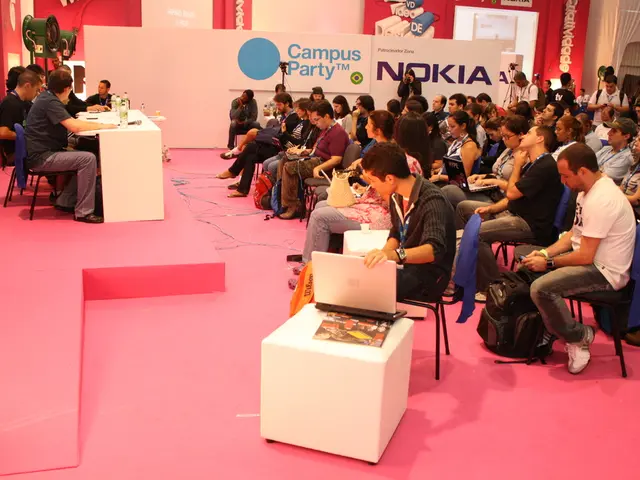Technology's Impact Reshaping Arts and Entertainment Sector
In the 21st century, the arts and entertainment industry has experienced a seismic shift, propelled by technological advancements that have impacted every facet of the sector. Today, technology lies at the heart of content creation, distribution, consumption, and engagement, modifying the very nature of art and entertainment.
- The Evolution of Digital Content Creation
The democratization of content creation is one of the most significant consequences of modern technology. With powerful tools at their fingertips such as digital video editing software, digital music production platforms, and 3D rendering programs, individuals with limited resources can now create high-quality content independently. This shift has marked a new era in the independent creative movement, allowing the sharing and distribution of works on a global scale.
Streaming platforms like Netflix, Spotify, YouTube, and Apple Music have also altered the sphere of content consumption. The age of CDs, DVDs, and cinema releases is being replaced by digital streaming services, offering audiences instant access to an array of content around the world. While this transformation redefines how artists share their works, streaming platforms have also opened new revenue streams such as subscriptions, advertisements, and pay-per-view options for creators.
- The Role of AI in Art and Entertainment
Artificial intelligence (AI) and machine learning are leaving their mark on the artistic process, particularly in music, film, and visual art. In music, AI algorithms can discern patterns in existing compositions, generating original music based on these patterns. The emergence of AI-created music fosters a new wave of artists using technology as a creative instrument.
In film and television, AI is being employed in editing, special effects, and color grading to streamline post-production processes and enhance efficiency. Additionally, AI technology is driving the development of deepfake technology, which can create hyper-realistic digital representations of people, posing both artistic opportunities and ethical challenges.
- Virtual Reality and Augmented Reality: The New Frontier
Virtual reality (VR) and augmented reality (AR) are expanding the horizons of the arts and entertainment world by providing immersive experiences that were once unattainable. VR allows viewers to step directly into films, video games, or installations, providing a fully immersive 3D environment. This technology presents new opportunities for interactive storytelling, particularly in gaming experiences where players can physically engage and influence the narrative through their movements.
In the visual arts, VR enables artists to develop interactive exhibitions, making it possible for audiences to explore digital installations in three dimensions. Museums and galleries are embracing this technology by offering virtual tours, opening an entirely new world for art enthusiasts unable to travel. Similarly, AR is enhancing live performances, offering audiences a new level of interactivity.
- Social Media and the ascension of Influencers
Social media platforms such as Instagram, TikTok, and Twitter have drastically transformed the relationship between creators and their audiences. Artists can share their work with global communities directly, circumventing traditional gatekeepers like galleries or record labels. The direct link created between creators and their audiences gives rise to influencers, who promote creative works to millions of followers.
For performers, social media serves as a crucial tool for building personal brands and engaging with fans. Musicians, actors, and visual artists can showcase their work, release new projects, and communicate with their audiences live and unfiltered, fostering a more intimate relationship between creators and their communities.
- Emerging forms of Interactive and Immersive Experiences
As technology continues to progress, new and captivating forms of entertainment are emerging, blurring the lines between traditional media and interactive experiences. Interactive storytelling, live-streamed performances, and digital events are gaining popularity amongst audience members seeking more immersive and participatory forms of entertainment. Additionally, blockchain technology is introducing new ways of owning and trading digital art, establishing innovative business models for creators and collectors alike.
In conclusion, technology will play an integral role in shaping the future of the arts and entertainment, transforming content production, distribution, consumption, and engagement. The convergence of artificial intelligence, virtual reality, augmented reality, streaming platforms, social media, and new technologies will forever change the landscape of creative industries, offering endless opportunities for innovation and creativity.
The rapid advancements in technology have empowered creators, altered consumption habits, and introduced entirely new mediums for arts and entertainment. These transformations have resulted in a more accessible, dynamic, and creator-centric industry.
Published: 25th February 2025
For more articles like this, follow us on Twitter, LinkedIn, and Instagram.
Also Read:
Wellness Destinations To Visit In 2025The Best Sports for Weight Loss: Which One Is Right for You?10 Dazzling New Luxury Hotels Opening in 2025
The democratization of content creation has made it possible for individuals with limited resources to produce high-quality, independent works and share them on a global scale due to streaming platforms.
Artificial intelligence (AI) has been influencing the artistic process, mainly in music, film, and visual art, with AI algorithms generating original compositions and enhancing post-production processes in film and television.
The virtual and augmented reality technologies are proving to be game-changers in the arts and entertainment world by offering immersive experiences, interactive storytelling, and even new forms of digital art ownership.
Social media platforms have profoundly changed the relationship between artists and their audiences, facilitating influencer culture, direct creator-to-audience interactions, and the sharing of creative works without traditional gatekeepers.
These transformations have led to a more creative, accessible, and interactive arts and entertainment industry, continually evolving in response to rapid technological advancements.








